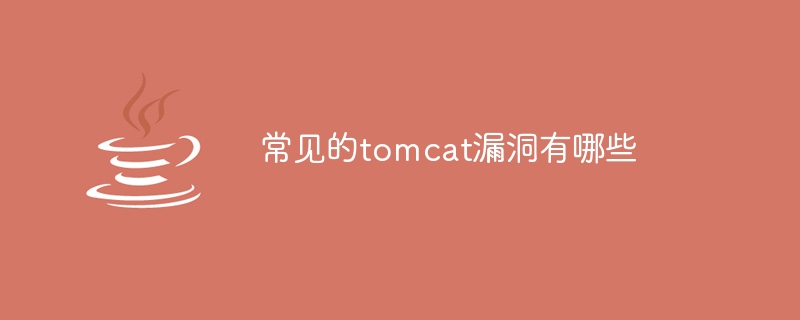Home >Java >javaTutorial >What are the common tomcat vulnerabilities?
What are the common tomcat vulnerabilities?
- 百草Original
- 2023-12-26 17:36:361700browse
Common tomcat vulnerabilities include: 1. Cross-site scripting attack; 2. Cross-site request forgery; 3. Directory traversal vulnerability; 4. Buffer overflow vulnerability; 5. Configuration vulnerability; 6. Third-party component vulnerability . Detailed introduction: 1. Cross-site scripting attack. Attackers inject malicious HTML or JavaScript code into web applications to induce users to click or perform certain operations, thereby stealing users' sensitive information or conducting phishing attacks on users; 2. Cross-site request forgery, where attackers forge authentication tokens from trusted websites, etc.

The operating system for this tutorial: Windows 10 system, DELL G3 computer.
Common Tomcat vulnerabilities mainly include the following aspects:
1. Cross-site scripting attack (XSS): Attackers inject malicious code into web applications HTML or JavaScript code induces users to click or perform certain operations, thereby stealing users' sensitive information or conducting phishing attacks on users.
2. Cross-site request forgery (CSRF): The attacker uses the user's authentication information on the target website to perform malicious operations by forging authentication tokens from trusted websites. , such as changing user passwords, sending spam, etc.
3. Directory traversal vulnerability: An attacker attempts to access sensitive files and directories on the Tomcat server by entering special characters in the URL, thereby obtaining sensitive information or performing malicious operations.
4. Buffer overflow vulnerability: An attacker can cause a buffer overflow by sending an overly long request or data in a specific format to the Tomcat server, thereby executing arbitrary code or causing a denial of service attack. .
5. Configuration vulnerabilities: Tomcat's configuration vulnerabilities include unauthorized access, unverified user input, unsafe default configuration, etc. These vulnerabilities could allow an attacker to obtain sensitive information, perform arbitrary actions, or bypass authentication.
6. Third-party component vulnerabilities: Tomcat integrates many third-party components, such as JSP, tag libraries, etc. These components may have known security vulnerabilities, and attackers can use these vulnerabilities to attack the Tomcat server.
In order to prevent the occurrence of these vulnerabilities, a series of security measures need to be taken. The following are some common security measures:
1. Input verification and filtering: Conduct strict verification and filtering of user input to ensure that the input data conforms to the expected format and type, and Avoid injection attacks.
2. Output encoding: Properly encode the data output to the client to avoid cross-site scripting attacks.
3. Authentication and authorization: Use strong password policies and multi-factor authentication to authenticate users and restrict access to sensitive resources.
4. Session management: Use a secure session management mechanism, such as using HTTPS, setting an appropriate session timeout, etc.
5. Configuration management: Ensure the security of the Tomcat server configuration file, such as restricting access to sensitive files, using safe default configurations, etc.
6. Update and patch management: Timely update the Tomcat server and related third-party components to ensure that they use the latest security patches and fixes.
7. Logging and monitoring: Enable appropriate logging and monitoring mechanisms to detect abnormal behaviors and security events in a timely manner.
8. Security audits and testing: Conduct regular security audits and tests to check for potential security holes and weaknesses.
In short, in order to ensure the security of the Tomcat server, a series of security measures need to be taken to prevent common vulnerabilities and attacks. This includes input validation and filtering, output encoding, authentication and authorization, session management, configuration management, update and patch management, logging and monitoring, and security auditing and testing, among others. At the same time, continuous attention and updates to these security measures need to be maintained to cope with ever-changing security threats.
The above is the detailed content of What are the common tomcat vulnerabilities?. For more information, please follow other related articles on the PHP Chinese website!

